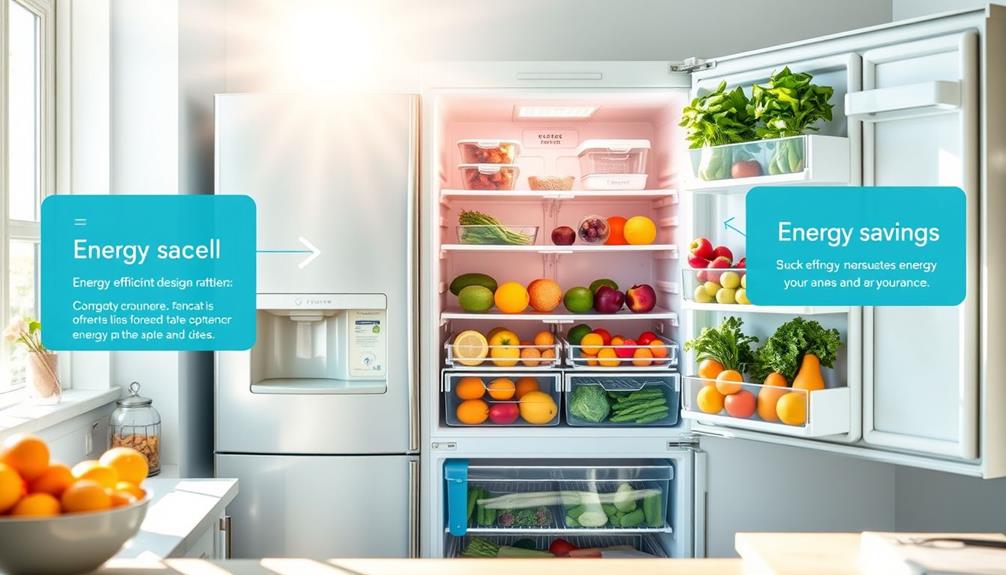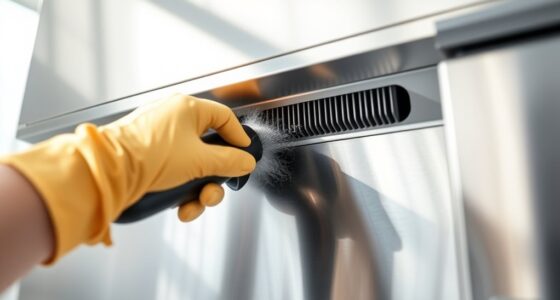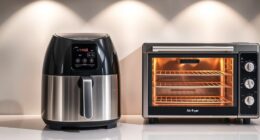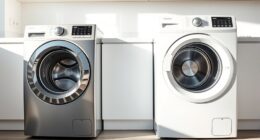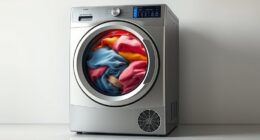You can generally use most 240V appliances in countries with a 220V standard. These appliances usually operate well within the voltage tolerances, as many countries have a nominal voltage of around 230V. However, it is important to verify the appliance’s specifications to ensure compatibility and prevent potential damage. While most newer models can handle slight differences without problems, older appliances designed for 220V may not function properly. Always refer to the manufacturer’s guidelines for safety assurance. If you are interested in specific models or the best practices for using your appliances overseas, there is more information you can explore.
Key Takeaways
- Most 240V appliances can operate safely on a 220V supply due to voltage tolerance levels.
- Check the appliance's voltage rating to ensure compatibility, especially for older models.
- Operating a 240V appliance on a 220V system usually does not cause damage or performance issues.
- Ensure power strips and outlets are rated for the correct voltage to avoid complications.
- Always verify with manufacturer specifications to prevent warranty voids and safety hazards.
Understanding Voltage Standards
When you plug in an appliance in a 220V country, it's essential to understand the voltage standards that govern its operation.
In Europe, the nominal voltage standard is set at 230V, with a tolerance range of -10% to +10%. This means your appliance can safely operate between 207V and 253V. If you're using a 240V appliance, you can rest easy—it's designed to function well within this range.
Additionally, understanding how to hedge against potential risks and volatility in markets, similar to Gold IRA benefits, can provide peace of mind when investing in appliances for international use.
The UK follows a similar standard, using 230V but with slightly different tolerances of -6% to +10%. This still allows for effective use of 240V appliances.
Modern 220V systems are compatible with 240V devices, ensuring that you won't damage your appliance just by plugging it in.
Even older 220V appliances align with these modern 230V European standards, giving you a wide variety of options.
However, always check the manufacturer's specified voltage for your appliances. Using the incorrect voltage can lead to damage and may void any warranties.
Understanding these voltage standards helps you use your appliances safely and effectively, regardless of where you are.
Compatibility of Appliances
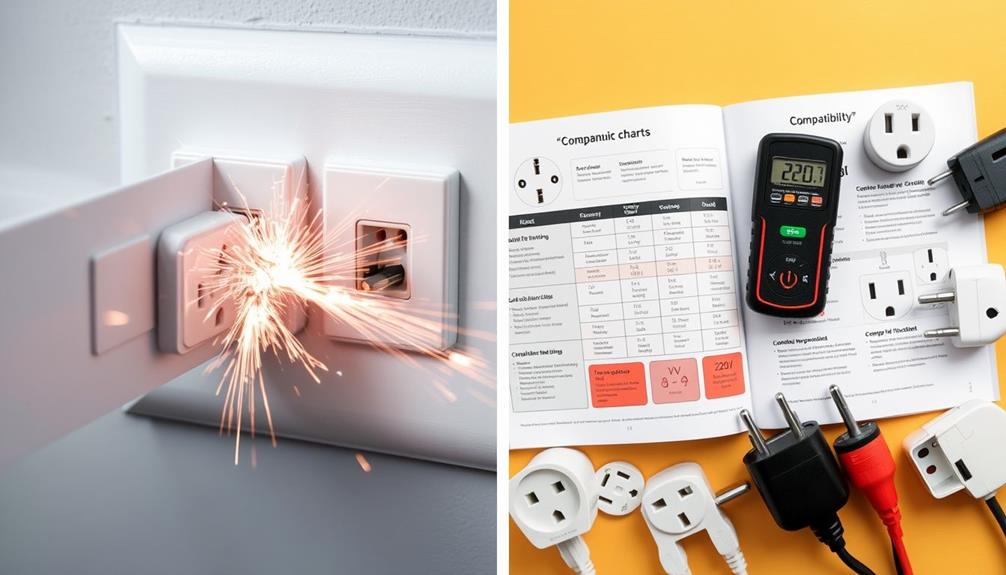
Understanding the compatibility of appliances across different voltage systems is vital for safe operation. If you're using 240V appliances in a 220V country, you'll find that many modern devices can function well due to their built-in tolerance for voltage variation.
Additionally, it's important to take into account that HVAC maintenance can enhance the efficiency of appliances used in a household environment. Here are some key points to take into account:
- Voltage Tolerance: Most 240V appliances are designed to handle slight voltage differences, making them generally compatible with 220V systems.
- Manufacturer Specifications: Always check the voltage rating on your appliance. If it specifies a lower voltage than 240V, you might be at risk for damage if the voltage fluctuates.
- Older Appliances: Be cautious with older appliances rated specifically for 220V, as they may not work properly on a 240V system.
- Warranty Concerns: Using appliances outside their voltage specifications can void warranties, so it's essential to verify compatibility before plugging in.
Australia's Voltage System

In Australia, the electrical system operates at a nominal voltage of 240V, which is slightly higher than the European standard of 230V. This means that most appliances designed for 240V can function safely on the Australian electrical power supply, thanks to the nominal voltage compatibility. So, if you're bringing appliances from countries with a similar voltage, you're likely in good shape.
Additionally, the significance of proper voltage guarantees that your appliances run efficiently without risk of damage.
The standard frequency for electricity in Australia is 50 Hz, aligning with many other nations that use similar voltage levels. However, it's crucial to check your device specifications before plugging anything in. Not all appliances are created equal, and using one not designed for 240V could lead to potential damage.
Additionally, Australia uses Type I electrical plugs, which feature two flat pins arranged in a V-shape and a grounding pin. If you plan to use your 240V appliances in Australia, make sure you have the appropriate adapters for these Type I plugs.
This way, you can enjoy your devices without worrying about compatibility issues. Remember, proper precautions make all the difference!
Outlet Differences Explained
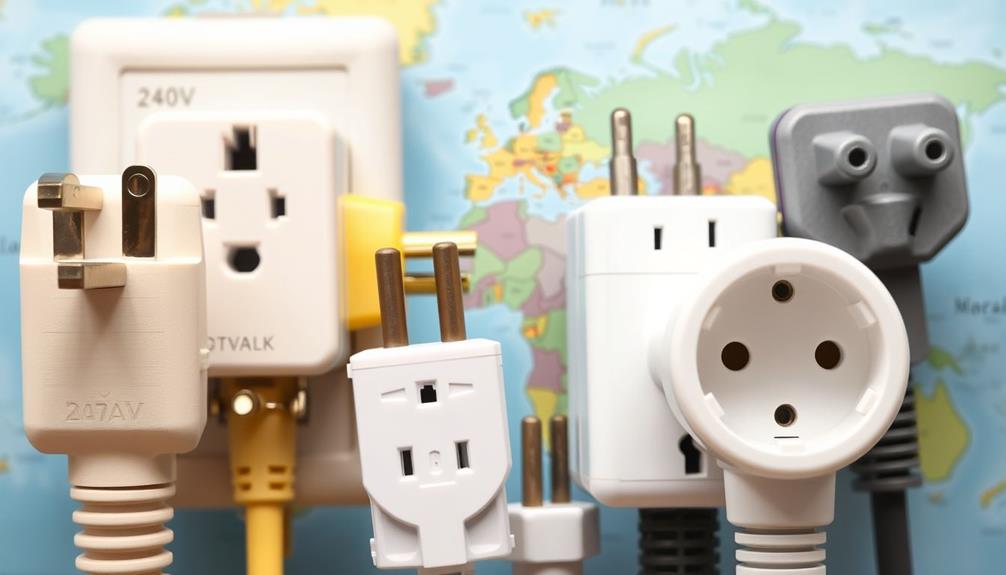
When you plug in a 240V appliance in a 220V country, you might wonder about compatibility issues and outlet power ratings.
While most 240V devices can handle a 220V supply, some older appliances may not fare as well. It's crucial to check the specifications before you connect anything to avoid damage.
Additionally, ensuring that your appliance has modern safety features can help prevent any potential risks, much like how safety glasses provide critical eye protection in various environments.
Voltage Compatibility Issues
Voltage compatibility can be a significant concern for users of 240V appliances in countries where the standard is 220V.
Fortunately, most 240V appliances can operate safely on a 220V system. The voltage difference falls well within acceptable tolerances.
To guarantee a smooth shift, it's essential to understand the nuances of design thinking approaches that can help in problem-solving situations like these.
Here's what you need to know:
- Voltage Range: The European standard allows a range of 230V -10% to +10%, making 220V compatible.
- Performance: While your 240V appliance may function on 220V, it mightn't perform at full capacity.
- Manufacturer Specifications: Always check the manufacturer's guidelines to guarantee that your appliance can handle the lower voltage without issues.
- Older Equipment: Compatibility issues may arise with older or specialized devices that aren't designed for voltage variations, potentially leading to operational problems.
Outlet Power Ratings
Understanding outlet power ratings is vital for anyone using appliances across different voltage standards. In many regions, you'll find 220V outlets in residential settings, while 240V outlets are typically reserved for high-power appliances like stoves and dryers.
When it comes to voltages used, 240V outlets provide about 10% more power than their 220V counterparts, allowing most modern appliances rated for 240V to function safely on a 220V supply without significant issues. Additionally, it's important to verify that any audio or visual equipment, such as home theater setups, is compatible with the voltage to avoid performance issues.
However, it's essential to check manufacturer specifications to confirm your appliance can handle the voltage supplied. While using a 240V appliance in a country with a 220V standard usually doesn't pose a risk of damage, you should exercise caution, especially with older or non-compliant devices. These could overheat or face performance issues.
If you're using power strips, confirm they're rated for the appropriate voltage. Not all power strips can handle the differences in outlet power ratings, which could lead to complications.
Always double-check compatibility to avoid any potential hazards. By understanding these outlet differences, you can use your appliances safely and efficiently around the world.
Risks of Voltage Substitution
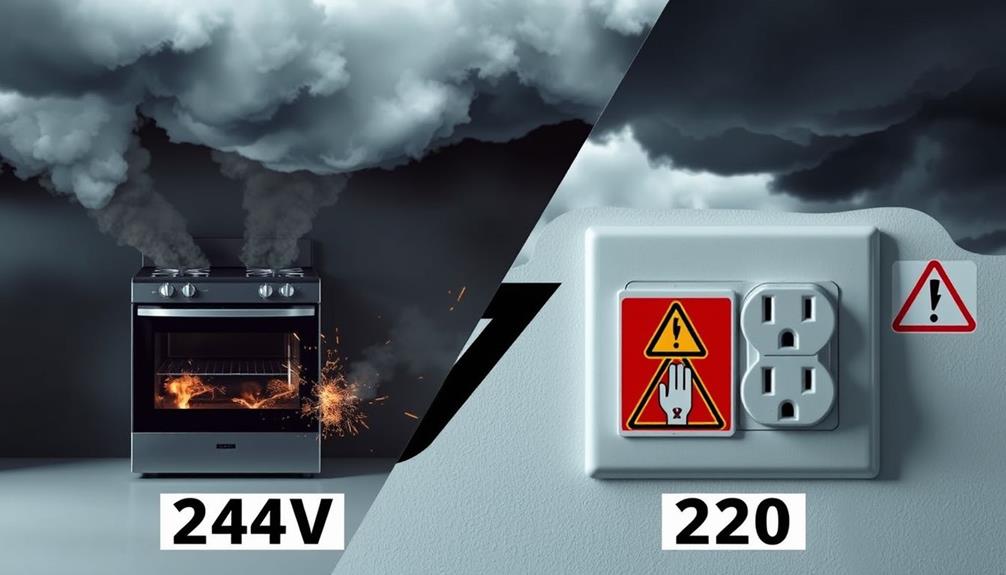
When you're using a 240V appliance in a 220V country, you need to be aware of the risks involved.
Substituting appliances can lead to damage, especially if the device isn't rated to handle the lower voltage. This situation can be likened to the importance of understanding cybersecurity measures when operating in different environments, as both require adherence to specific standards to avoid failure.
Plus, running appliances outside their specified voltage can void warranties, leaving you responsible for any repairs or replacements.
Appliance Damage Risks
Using appliances designed for 240V in a country with a 220V supply can seem straightforward, but it comes with its own set of risks. While many modern appliances can handle the slight voltage difference, there are still significant appliance damage risks to take into account.
For instance, diversification of retirement portfolios enhances financial security, much like investing in voltage-compatible appliances enhances their longevity.
Here are four key points to keep in mind:
- Underperformance: If your 240V appliance frequently encounters a 220V supply, it may underperform or malfunction due to insufficient voltage.
- Overheating: Appliances rated for 220V may struggle with a 240V supply, leading to overheating and potential failure.
- Warranties: Operating outside manufacturer-specified voltage can void warranties, making you liable for repair costs if damage occurs.
- Safety Hazards: Voltage substitution can introduce serious safety hazards, including fire risks, especially if the appliance isn't designed to handle such variations.
To protect your investment, weigh these risks carefully before using your 240V appliance in a 220V environment. Understanding these factors can help you avoid costly repairs and maintain your safety.
Warranty Voids Consequences
Operating a 240V appliance in a 220V country can lead to serious warranty issues. Many manufacturers clearly state that using appliances outside their designated voltage range may void the warranty. If you decide to use your 240V appliance, you might find yourself responsible for all repair or replacement costs if something goes wrong.
Here's a breakdown of potential warranty consequences:
| Consequence | Details |
|---|---|
| Warranty Void | Using outside voltage specifications voids the warranty. |
| Repair Costs | You're responsible for repairs if the appliance fails. |
| Replacement Costs | If damaged, you'll need to buy a new appliance. |
| Performance Issues | The appliance might not function properly, affecting efficiency. |
| Safety Hazards | Incorrect voltage can lead to electrical fires or other dangers. |
Using a 240V appliance in a 220V environment can pose risks not just to the appliance's functionality but also to your safety. Always check the manufacturer's specifications before making such a decision to guarantee you don't end up with a costly warranty void.
Voltage Tolerance Limits
Understanding voltage tolerance limits is essential for anyone using 240V appliances in 220V countries.
European and UK standards allow for variations that can accommodate your appliances safely. It's also important to take into account how yoga practices can help manage stress, which may arise from concerns about using incompatible appliances.
Here's what you need to know:
- European Standard: The tolerance range is 230V -10% to +10%, which means your 240V appliance can operate between 207V and 253V.
- UK Standard: With a tolerance of 230V -6% to +10%, the acceptable range is from 216V to 253V, still supporting 240V appliances.
- Compatibility: Appliances designed for a nominal voltage of 230V can work with both 220V and 240V systems, handling slight voltage variations without damage.
- Manufacturer's Guidance: Always check the manufacturer's specifications before usage, as incorrect voltage can lead to serious equipment damage.
While using a 240V appliance in a 220V country is generally safe, understanding the voltage tolerance limits will help you avoid potential risks.
Being informed can protect your investment and guarantee your appliances function properly across different voltage standards.
Checking Appliance Specifications
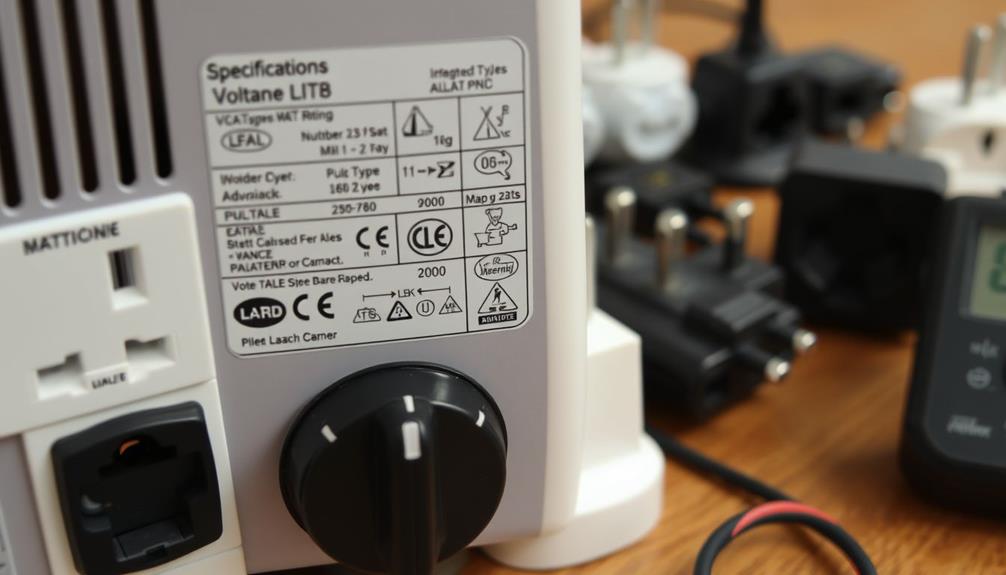
When checking appliance specifications, it's essential to look closely at the voltage requirements listed on the nameplate or in the user manual. Appliances labeled for 240V operation can often be used in 220V countries, as the voltage difference typically falls within acceptable tolerance ranges.
Additionally, understanding the importance of setting realistic goals for appliance compatibility can help prevent frustration. However, always verify the manufacturer's specifications since some appliances may require a specific voltage to operate safely.
If your appliance is designed for 230V, it should work well on both 220V and 240V systems due to built-in tolerances for voltage variation. Operating a 240V appliance on a 220V system may result in slightly reduced performance, but it's unlikely to cause any damage.
To confirm compatibility with local electrical standards, always double-check the voltage requirements. This step is especially important if you're traveling or relocating to a country with a different voltage standard.
Understanding these specifications can save you from potential issues, confirming your appliances function safely and effectively. Don't overlook this vital detail; it could make a significant difference in your appliance's performance and longevity.
Electrical Services Contact
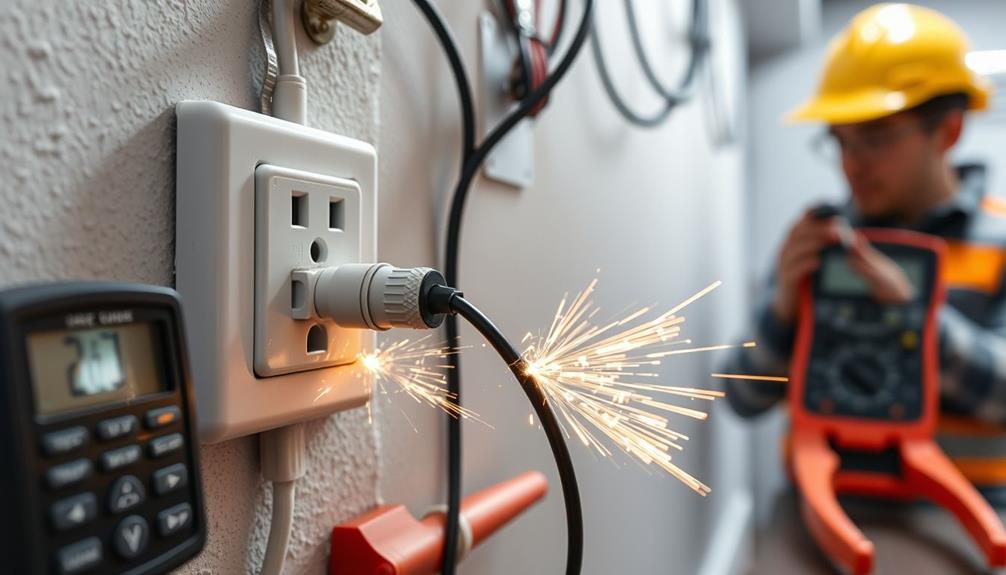
If you find yourself needing assistance with your electrical appliances, it's beneficial to have a reliable service provider on hand.
Finnley Electrical is an excellent choice for professional electrical services in Sydney, whether you're dealing with residential or commercial needs. With a commitment to electrical safety and compliance with local regulations, you can trust their experienced professionals to handle your issues effectively.
Here are some reasons to reach out to Finnley Electrical:
- Lifetime Labour Guarantee: They stand by their work, ensuring quality and reliability.
- Quick Assistance: Their team is ready to tackle urgent electrical problems swiftly.
- Expertise: With a focus on safety, you can rest easy knowing your appliances are in capable hands.
- Contact Number: For assistance, simply call their contact number at (02) 8605 4974.
Don't hesitate to reach out to Finnley Electrical when you need help with your appliances.
Their dedicated team is enthusiastic to assist you, ensuring your electrical systems run smoothly and safely.
Global Voltage Variations
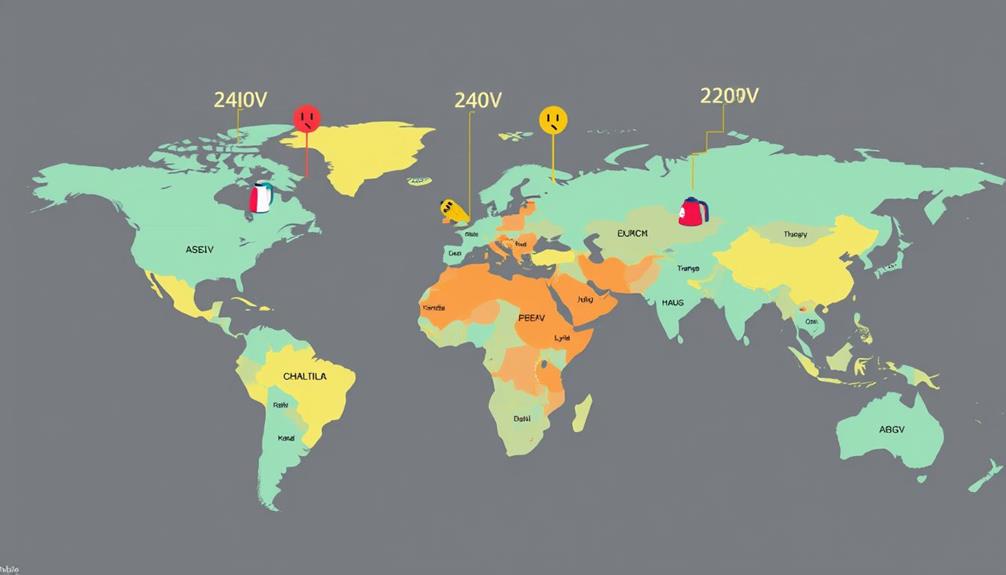
While many countries adhere to a nominal voltage standard of 230V, this range often allows 240V appliances to function seamlessly within a 220V system. Countries like those in Europe have established this standard, which includes tolerances from 207V to 253V.
This flexibility means that your 240V appliances can generally operate safely on a 220V supply without issues.
In Australia, where the standard is 240V, most appliances are designed to work at either 220V or 240V, showcasing the adaptability of electrical systems. Countries that utilize a 220V standard typically have their electrical infrastructure built to handle voltage variations, minimizing the risk of damage to your appliances.
However, it's vital to always check the manufacturer's specifications before plugging in your devices. Using appliances outside their rated voltage can void warranties and potentially lead to damage.
By being mindful of these global voltage variations, you can guarantee that your appliances function correctly and safely, regardless of where you are.
Frequently Asked Questions
Will 240V Appliances Work on 220v?
Yes, 240V appliances typically work on 220V. They're designed to handle voltage variations, so you won't face damage. Just check the manufacturer's specifications to confirm safe operation and avoid potential issues.
Can I Use a 240V Appliance in Europe?
You can use a 240V appliance in Europe, but check the manufacturer's specs first. Most appliances handle slight voltage differences safely, though be cautious with high-power devices due to potential local voltage fluctuations impacting performance.
Can I Use 230V Appliance in 220v?
You might worry about using a 230V appliance on a 220V supply, fearing damage. However, you can relax; these devices usually operate well within tolerances, ensuring safety and functionality without significant performance loss.
How Can I Use 110V Appliances in a 220V Country?
To use 110V appliances in a 220V country, you'll need a voltage converter to safely reduce the voltage. Always check your appliance's specifications to avoid damage, and consider using a plug adapter for outlet compatibility.
Conclusion
In summary, when traveling or relocating, it's essential to understand voltage standards. You can safely use 240V appliances in countries with a 220V standard, but always check compatibility first. Verify your appliance specifications match, adapt if necessary, and be aware of outlet differences. By being informed and cautious, you can enjoy your devices without worry. So, stay safe, stay smart, and enjoy your travels while keeping your electronics powered and ready!



